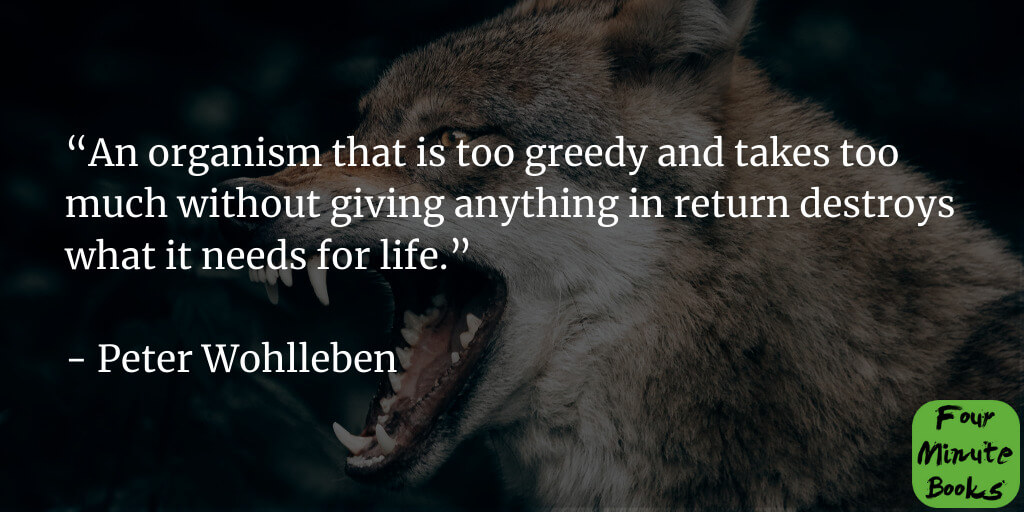1-Sentence-Summary: The Inner Life of Animals presents complex research on animals and the life of our ecosystem, which is not so different than ours, given that they can feel pain, experience emotions, and share other similarities with us, humans.
Read in: 4 minutes
Favorite quote from the author:

While science is particularly focused on the remarkable evolution of humans, some researchers found a handful of pretty amazing insights about animals and plants too. It seems that despite our differences, we share a lot of similarities.
Much like humans, animals do feel a variety of emotions. They’re also intelligent and remember common patterns. The Inner Life of Animals by Peter Wohlleben looks at how different species behave and feel emotions. This way, we can understand them in-depth and develop a sense of empathy towards them.
Here are three of my favorite lessons from the book:
- In order to begin understanding animals, we have to stop categorizing them.
- Humans and animals are alike through their behavior.
- Just like us, animals have emotions that we can relate to and make sense of to get to know them better.
If you want to learn more about your pet bestfriend or the animal world overall, stick around as we’ll explore each lesson in detail.
Lesson 1: All animals are part of our life, regardless of our classification of them and their popularity
Naturally, the most popular animal for humans is the dog. Dogs are great animals and we even call them man’s best friend. While there’s no doubt that they’re intelligent beings and that we share many similarities, it seems that we’re paying little to no attention to other creatures.
This is because industries and the research that supports them aren’t trying to advertise animals like pigs or cows as intelligent beings. After all, no one wants to deepen their knowledge and develop empathy towards their future meals. Although it sounds bitter, this truth is blinding us from reality.
As humans, we must educate ourselves on all beings and develop empathy towards them. After all, we’re all creatures of the earth. Even more, recent studies suggest that they can feel emotions too and that they have complex inner lives.
When we stop categorizing them into good and bad, smart or stupid, useful or useless, we’ll realize that animals are part of our life. They help us survive and all have a purpose, just like humans. Moreover, a bit of research on this matter will teach you that animals such as pigs are also smart and even clean!
Lesson 2: Much like animals, human behavior is determined by hormones and instinct
People argue that animals act based on hormones and instincts and that they do not feel emotions at all. However, when you look at humans, there’s not much evidence to suggest different behaviors. Take squirrels for example. When a mother squirrel is in danger, it’ll pull her baby away and run till it collapses out of exhaustion.
Isn’t that a mother’s behavior in any species? Mothers are known to act irrationally when it comes to their babies and protect them at all costs. This is a hormonal response, yet that doesn’t make it less valid. We do share many similarities with our fellow animal species!
Instinct comes first with animals, yet that doesn’t mean we, as humans, are less driven by it. For example, when you touch fire or something hot, you immediately pull your hand away, without your consciousness even registering that sensation first — that’s instinct.
Lesson 3: Animals feel good and bad emotions, and that can help us understand and bond with them
There’s no doubt that humans love animals, and that our pets feel some sense of attachment to us as well. Whether that’s love or not, science tends to disagree that they can feel such complex emotions. Animals see us as food providers and caregivers, yet our relationship with them might be more complex than that.
Even if they probably can’t feel the same way about us, that doesn’t invalidate their emotions. It just makes us understand them more and learn their language. For example, for humans, it might be a sign of affection to overfeed our pets on holidays, dye their hair, or overdress them, while this might not benefit them at all.
Understanding leads to empathy. Validate their inner lives and get to know their behaviors if you truly love them. Another aspect to remember is that our beloved pets feel pain and fear. To rip their babies away from them, traumatize them with aggressive behavior, or other such practices is detrimental to them.
Regardless of how they intercept these emotions, whether they’re hormonal or instinctual responses, they’re valid and they exist. Therefore, to become closer to them is to understand their pain and empathize. Try loving them and caring for them not just because we share a home, but because they feel everything.
The Inner Life of Animals Review
The Inner Life of Animals presents the similarities between humans and animals, and builds a case for all earth’s species to live in peace, coexist, and understand each other. Reading this book will deepen your knowledge of how animals feel, react, sense each other and us humans, and how we can empathize with them more. Moreover, it will help you let go of assumptions that make you think some animals are useless, bad, or uninteresting while helping you embrace the bigger picture of life.
Who would I recommend The Inner Life of Animals summary to?
The 30-year-old person who wants to escape excessive consumerism and get closer to nature, the 27-year-old person who is looking to stop eating meat out of empathy for animals, or the 40-year-old pet owner who wants to understand more about their beloved animal best friend.
Last Updated on October 6, 2022